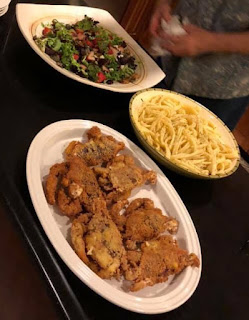Earlier this week, after a day of pruning in the vineyard, my husband said that we should have fish for dinner. I concurred because any time my husband cooks, it will be delicious! When we went to our favorite fish monger, they had Maryland soft shelled crabs and immediately, our dinner changed from Fish en Papillote to deep fried Maryland soft shelled crabs. The fish monger had already cleaned the crab so this purchase was a no brainer.
We always have panko on hand so my husband went to work on deep frying this delicacy. If you have never had fresh Maryland soft shelled crab, you are missing a culinary experience. Fresh! that is the key. After tasting the crab, we knew what we would make for our friends who would be coming over for dinner on Sunday. Typically, our friend's husband is a meat and potatoes kind of of guy so we were thinking smoked cowboy steaks, but the Maryland soft shell crab floated to the top of the menu choices so all that remained was for us to reserve 6 Maryland soft shelled crabs. Done!
We knew all along that we were going to share this bottle of Birichino Pétillant Naturel with our friends and our initial thought was to begin with Birichino and fresh oysters. With the soft shelled crab on the menu, we knew that the Birichino would be paired with dinner.
Our friends knew the story of how we got this Birichino, so bare with me while I digress a little. In January, I was in Hawaii, attending my mother's 90th birthday and had contacted Chuck Furuya (10th Master Sommelier in the USA) and he graciously agreed to meet me. So, on a Sunday evening, my two daughters and I went to
Vino and had a delicious dinner. Throughout the evening, Chuck would stop by our table and tell us about the menu and how the food was sourced, or just give us a thumbs up. At the end of the evening, he sat down at our table and we had an uproariously good time and as we left, Chuck gifted us with this bottle of Birichino, after he heard that my husband and I are making
Chenin Blanc Pétillant Naturel in Connecticut.
So, on Sunday night, our friends brought over appetizers and a salad. We paired the soft cheeses that they brought with a sparkling wine from Long Island. My husband kept the soft shell crabs under wrap until it was time to toss them into the deep fryer.
Our friend loves soft shell crab and any time it is on the menu, she will gravitate to ordering the dish. As my husband was cooking, our friend told us her story about catching a soft shell crab in her youth and cooking it and sharing one soft shell crab with her three other friends. So I knew the rest of the story about her love of soft shell crab.
What is wine and food about? It is the marriage of the perfect pairing that makes a lasting memory. We had a wonderful dinner and hopefully a memorable send off for our friends who are beginning their 6 week cross country trip. Bon Voyage!



























